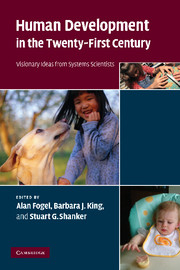Book contents
- Frontmatter
- Contents
- List of contributors
- Introduction: Why a dynamic systems approach to fostering human development?
- Part I Dynamic relationships between genetics and environments
- Part II The dynamic system of the child in the family
- Part III The dynamic system of the child in social and physical environment
- 10 The tempest: anthropology and human development
- 11 An anthropology of human development: what difference does it make?
- 12 The social child
- 13 Learning about human development from a study of educational failure
- 14 Dynamic views of education
- 15 Embodied communication in non-human animals
- 16 Children in the living world: why animals matter for children's development
- Part IV Dynamic systems approaches to mental health
- Part V Conclusions and outlook
- Index
- References
15 - Embodied communication in non-human animals
Published online by Cambridge University Press: 22 September 2009
- Frontmatter
- Contents
- List of contributors
- Introduction: Why a dynamic systems approach to fostering human development?
- Part I Dynamic relationships between genetics and environments
- Part II The dynamic system of the child in the family
- Part III The dynamic system of the child in social and physical environment
- 10 The tempest: anthropology and human development
- 11 An anthropology of human development: what difference does it make?
- 12 The social child
- 13 Learning about human development from a study of educational failure
- 14 Dynamic views of education
- 15 Embodied communication in non-human animals
- 16 Children in the living world: why animals matter for children's development
- Part IV Dynamic systems approaches to mental health
- Part V Conclusions and outlook
- Index
- References
Summary
I'm reading in my favorite chair, which rests on the floor at dog level. For the last twenty minutes my dog Bahati (“Ba” for short) has been resting out of sight contentedly gnawing a bone. But when I open my laptop with a click, she instantaneously materializes before me, like a character beamed from the Starship Enterprise. “Hey, Bahati,” I say, glancing at her briefly, and then resume typing. Without moving or making a sound, she compels my attention through the sheer intensity of her presence. I look up again and, for a few heartbeats, meet the steady gaze of her topaz eyes. Then, before she can distract me further, I say forcefully “You had a long walk. Now I need to work.” While I'm speaking, she flies through the air past me. As she whooshes by, she turns her head toward me so that her muzzle brushes my face just as I finish speaking. She twists in mid-air and lands facing me, sitting, about three feet away. Adopting an appealing expression, she lifts a paw and waves it up and down in front of me (not a trick she's been taught). Again I tell her that I need to work. Undaunted, she raises both paws at once, shifting her torso upright into full entreaty position. The thick mane of gold fur around her face and neck fluffs out as she rises, adding to her appeal. I lose my composure and start to laugh.
- Type
- Chapter
- Information
- Human Development in the Twenty-First CenturyVisionary Ideas from Systems Scientists, pp. 136 - 146Publisher: Cambridge University PressPrint publication year: 2007
References
- 5
- Cited by



